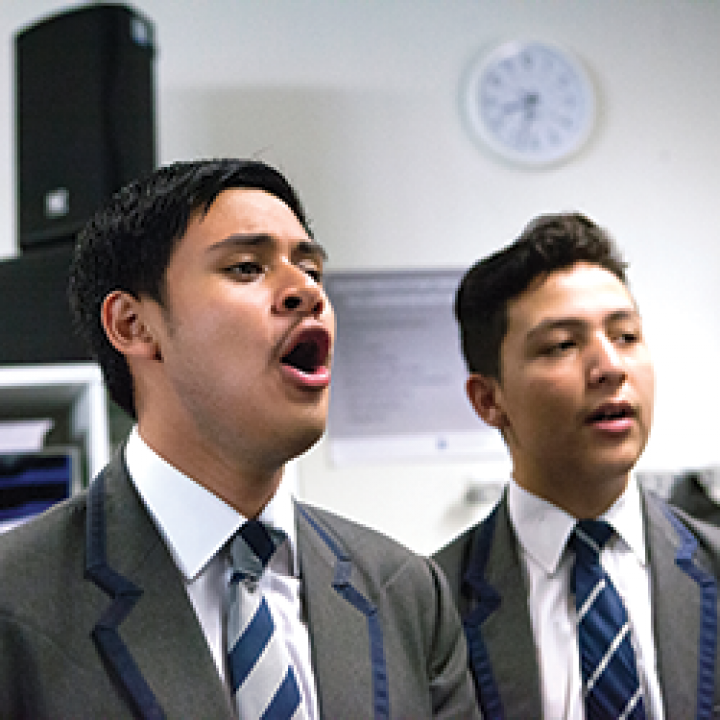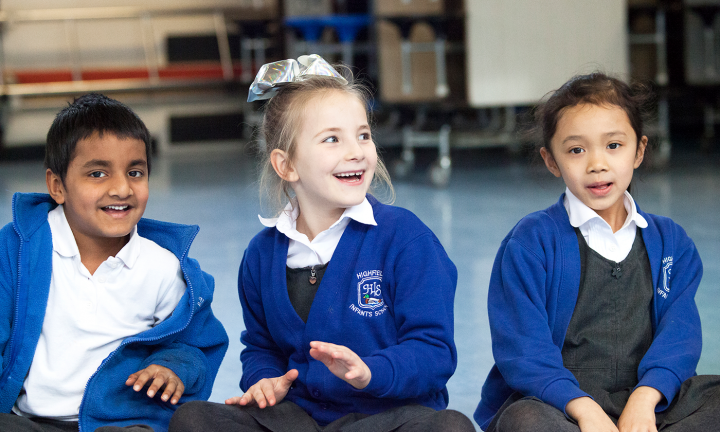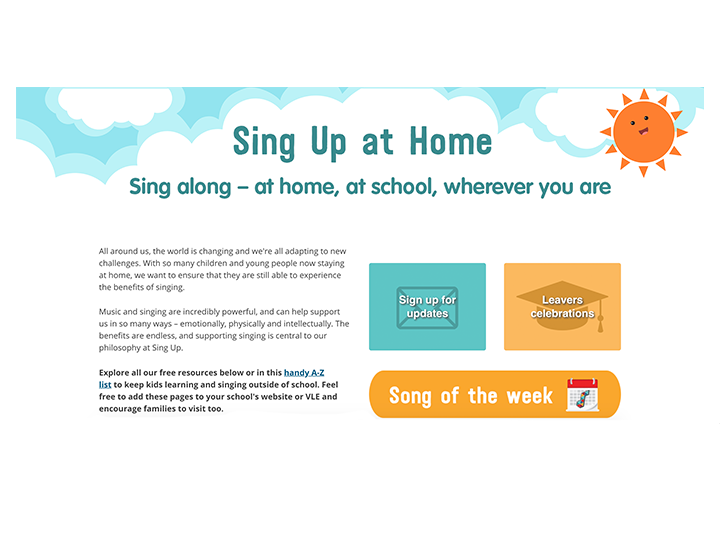
Phoene Cave investigates the everyday benefits of singing for breath and how, as a singing leader and teacher, you can ensure your children are breathing well to sing.
Breathing is a curious phenomenon. As adults, we breathe 12-16 times every minute, primary aged children 20-25 times. We don’t often notice it, it is invisible and yet, ‘Every feeling and thought, every mental and physical condition is first experienced and manifested in the breath.’ The Right To Speak by Patsy Rodenburg (Bloomsbury Methuen Drama)
Notice it now. Often when we are concentrating we hold our breath. Breath holds become so commonplace that we cease to notice and they can become our ‘new normal’. We then model these breathing patterns to the children we live or work with. The most important thing you can do is to take a moment to pause, connect with physical sensation and the movement of your breath. We do not have to be scared, upset or angry to ‘hold’ our breath.
‘There is not one correct way to breathe, but there are common ways in which people restrict their breathing.’ The Breathing Book by Donna Farhi (Henry Holt and Company Inc)
Singing to deepen breath
Singing is a simple and powerful way to deepen breathing.
10 years ago the first Singing for Breathing groups were started to support older adults with Chronic Obstructive Pulmonary Disease (COPD). More than 1.2 million adults in the UK have a diagnosis of COPD. The damage to the airways (primarily from smoking) causes coughing, wheezing, increased shortness of breath, increased mucous production and is progressive.
In 2013, the British Lung Foundation asked me to develop and deliver a training programme for singing leaders using singing as the tool to help participants feel in control of their breathing. The sessions contain a combination of physical warm-ups, musical games, vocal and breathing exercises, guided relaxation and appropriate songs, which enable the outbreath to lengthen across long phrases. There are now nearly 100 Singing for Lung Health groups in the UK. Participants report overwhelmingly positive and transformative experiences.
As Ruby Swift, Singing for Lung Health leader in Kidderminster observes, ‘For people with lung health conditions, the breath is often a barrier to living. When we sing, the breath enables creation of something new, promoting life not inhibiting it. It is the barrier that is forgotten, not the breath.’
I continue to work with respiratory research colleagues to build an even stronger evidence base to support the initial randomised control trials. The Sing Up Foundation is interested in looking at ways to support this ongoing work.
How can singing support lung health?
Singing supports children of all ages with compromised lungs.
You may have children in your class with asthma or cystic fibrosis for whom singing will be nothing but a positive experience and should be encouraged. Much of the lung health singing work provides musical tools for the self-management of breathlessness and also reassurance and a positive distraction.
If you have a lung disease, breathing suddenly becomes highlighted. Something we have taken for granted becomes a challenge. The main lung disease affecting children in the UK is asthma where different ‘triggers’ cause the airways to narrow and constrict.
Many towns and cities across the UK have unsafe levels of air pollution from traffic fumes, which can cause lasting damage to children’s growing lungs.
Children are exercising less and are subsequently less familiar with being happily breathless from physical activity. As well as a lack of physical exercise, a poor diet, damp living conditions, stressful home life and busy urban roads can really impact on a child’s ability to breathe. As breathing impacts on our lives so our lives impact on our breath.
However, through singing we engage muscles in the upper body that support the breathing mechanism. When we sing, the vocal folds vibrate and create resistance for the air leaving the body. Muscles around the ribcage and abdomen work together to sustain the pressure of the air flow in order to sustain pitch. Fundamentally this just means that our body and breath work harder simply by singing.
The benefits of group singing are physical, psychological, social and cognitive – stress levels reduce and oxygen levels in the bloodstream increase.
Getting ready to sing
Physical warm-ups are important to get the body ready to sing. You don’t need to do any particular breathing exercises with your children. If you focus too much on the children’s breathing, they may freeze, get confused, hold their breath, lift their shoulders or pull their tummies in when they inhale. There are some great exercises on the Sing Up website. Have a look at Rubber chicken and this warm-up sequence from our Sensational singing assemblies webinar by Gitika Partington.
You can also find video examples of exercises to use from Inside the voice. One of the most useful is the low breath i.e. releasing the tummy on the inhale and drawing it in towards the spine on the exhale. Try this to ‘pish’, ‘fff’, ‘sss’. You may like to use and adapt a couple exercises from my Singing for Breathing CD available here – you can have a sneak preview here.
The way we breathe when we sing has proved a powerful tool for those with respiratory conditions but the wider benefits are universal. It should remind us how important it is to become aware of our own breathing patterns every day. ‘The breath’s responsiveness and our awareness of it enable us to thrive in life.’ Breathe, Jean Hall (Quadrille).
Daily tips
- Check in with yourself to ensure you are relaxed, modelling well and ready to ‘inspire’ your singers.
- Alternate fast, staccato songs with legato, melodic songs – your song choices will give the children different experiences of breathing and support while singing – let the music do the work.
- Have a balance of repertoire including rhythm, pitch and body percussion games.
- Keep monitoring posture, especially head, neck and shoulder position.
- Avoid sitting – alternate standing and moving to allow the breathing mechanism the space it deserves.
- Keep the energy going all the way through the song – remind children that their breath is their POWER SOURCE which enables the vocal folds to vibrate and make the sound.
- Most importantly, relax and have fun!
Music projects supporting children's lung health
Vital Arts
Barts Health NHS Trust’s arts charity brought together a Speech and Language Therapist with LSO musicians in a pilot project to help inform parents and carers how to deepen their connection with their premature babies. Vanessa King, an LSO musician working at Whitechapel’s Royal London hospital, explains, ‘The highlight was when I sang to one tiny, wired-up premature baby who had very noisy, laboured breathing. He became totally calm in his breath and his facial features which in turn made his mum relax and the nurses too.’
Vocal Beats
A project run by rb&hArts, a charitably-funded hospital arts programme at Royal Brompton & Harefield NHS Foundation Trust, includes bedside singing for babies and families; creative music-making and beatboxing in small groups and one to one vocal coaching. Singing teacher Heather McClelland works with respiratory physiotherapist Charlotte Wells to develop diaphragmatic breathing through physical warm-ups, vocal exercises and songs for children with respiratory conditions. ‘Singing songs they know and love really helps with breath pattern work,’ says Wells.
Bronchial Boogie
Joint endeavour between Oldham PCT and Oldham Music Service teaching asthmatic children brass instruments.
Asthma choir
New choirs for children with asthma are currently being established in Wigan and Salford.
Useful websites
- http://bit.ly/su-blfsinging
- http://bit.ly/su-understandingasthma
- singup.org/percussionguide
- http://bit.ly/su-sdhbetterbreathing
- https://www.nature.com/articles/npjpcrm201680
- https://www.blf.org.uk/support-for-you/singing-for-lung-health
- http://www.artshealthandwellbeing.org.uk
- https://www.rbht.nhs.uk/about-us/our-charities-and-rbharts/rbharts/singing-for-breathing
- https://www.researchgate.net/profile/Graham_Welch/publication/273428150_The_Benefits_of_Singing_for_Children/links/550061710cf2d61f820d6e83.pdf
Further reading
Highly recommended introduction to how the voice works:
- This Is A Voice, Jeremy Fisher and Gillyanne Kayes (Profile, 2016)
The Breath:
- If In Doubt, Breathe Out!, Ron Morris and Linda Hutchinson (Compton Publishing)
- Breathe, Jean Hall (Quadrille, 2016)
- The Breathing Book, Donna Farhi (Holt Paperbacks, 1996)
Breathing and the voice:
- The Performer's Voice, Meribeth Bunch Dayme (WW Norton & Co, 2006)
- The Right To Speak, Patsy Rodenburg (Methuen Drama, 1992)



